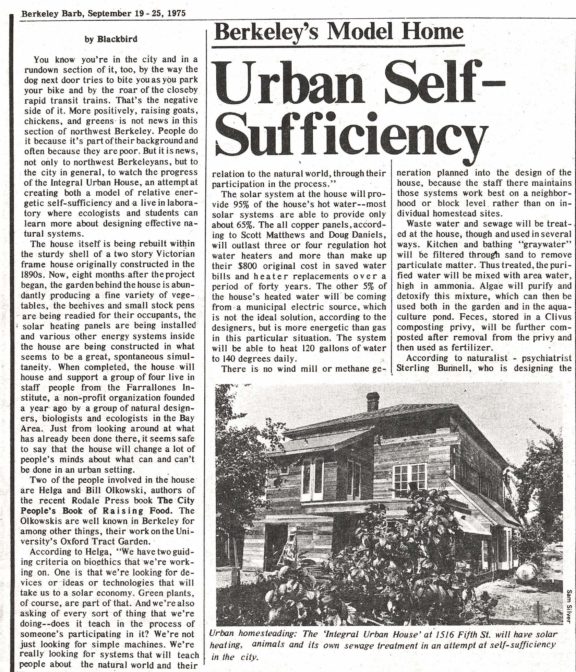In this enthusiastic full profile of the Integral Urban House as it approached completion, Berkeley Barb writer “Blackbird” explored both the workings of the house and the eclectic mix of people who came together and made this house a reality.
Titled “Berkeley’s Model Home: Urban Self-Sufficiency,” the piece draws on the language of the “model home” (usually used by developers and realtors) to suggest that the IUH is a prototype of a new home design, one that will lay the foundation for a better way of urban living, separate from the polluting and consumptive habits of society.
The article begins with a sentence appealing to a common preconception of what a shabby urban neighborhood looks like:
“You know you’re in the city and in a rundown section of it, too, by the way the dog next door tries to bite you as you park your bike and by the roar of the closeby rapid transit trains.”
But quickly, the author flips that statement on its head to introduce the potential for revitalization with the Integral Urban House. They highlight the collaborative and interdisciplinary nature of the house, which was founded by a group of “natural designers, biologists and ecologists.” The hands-on, educational aspect is also highlighted: “we’re also asking of every sort of thing that we’re doing – does it teach in the process of someone’s participating in it?” All of this demonstrates the IUH seeks to be different from other ecological or back-to-the-land projects.
The author is intrigued by the multiple systems working side-by-side, and is careful to not assume anything about the house. They closely cite people heavily involved with the projects like Helga and Bill Olkowski or solar specialists Scott Matthews and Doug Daniels. The text is peppered with quotes and the phrase “according to”. There is a tone of excitement that permeates the article, as if the author were excited by the prospect of a new experiment taking shape in Berkeley.
In the body of the article, the author focuses their report on the solar heating system and the aquaculture pond. These appear to be more radical, concrete projects that can be used to entice readers to check out the house. A lush garden is nice, but a solar water heater is more alluring as a feat of design and engineering. An aquaculture pond is much less common in homes, so it also piques others’ interests.
In the penultimate paragraph, the author writes “Along the way, additions and changes are sure to come”. They know experiments like the IUH are perpetually evolving, and they look forward to hearing how it will unfold in the future.
